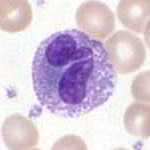Foam cells, also called lipid-laden macrophages, are a type of cell that contain cholesterol. These can form a plaque that can lead to atherosclerosis and trigger heart attacks and stroke.[1][2][3]
Foam cells are fat-laden M2 macrophages containing low density lipoproteins (LDL). They can only be truly detected by examining a fatty plaque under a microscope after it is removed from the body.[4] They are named because the lipoproteins give the cell a foamy appearance.[5]
Despite the connection with cardiovascular diseases they are not inherently dangerous.[6]
Foam cell
DetailsPrecursormonocyte-derived macrophageIdentifiersMeSHD005487FMA83586Anatomical terms of microanatomy
https://en.wikipedia.org/wiki/Foam_cell
Granulocytes are cells in the innate immune system characterized by the presence of specific granules in their cytoplasm.[1] They are also called polymorphonuclear leukocytes (PMN, PML, or PMNL) because of the varying shape of the nucleus, which is usually lobed into three segments. This distinguishes them from the mononuclear agranulocytes. The term polymorphonuclear leukocyte often refers specifically to "neutrophil granulocytes",[2] the most abundant of the granulocytes; the other types (eosinophils, basophils, and mast cells) have fewer lobes. Granulocytes are produced via granulopoiesis in the bone marrow.
| Granulocyte | |
|---|---|
 A basophilic granulocyte. | |
| Details | |
| System | Immune system |
| Identifiers | |
| MeSH | D006098 |
| FMA | 62854 |
| Anatomical terms of microanatomy | |
https://en.wikipedia.org/wiki/Granulocyte

No comments:
Post a Comment